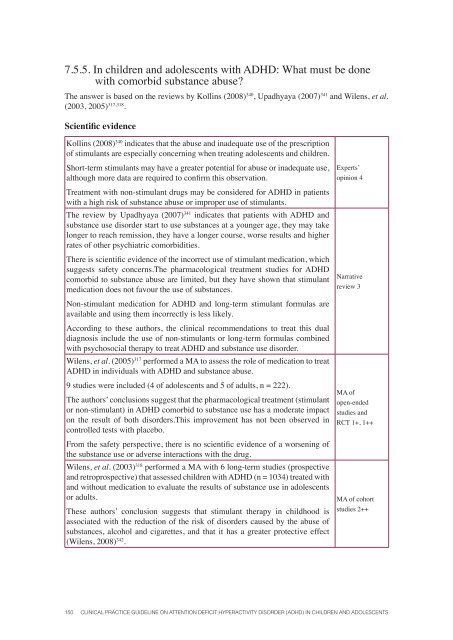CPG on ADHD
CPG on ADHD
CPG on ADHD
- No tags were found...
Create successful ePaper yourself
Turn your PDF publications into a flip-book with our unique Google optimized e-Paper software.
7.5.5. In children and adolescents with <strong>ADHD</strong>: What must be d<strong>on</strong>ewith comorbid substance abuse?The answer is based <strong>on</strong> the reviews by Kollins (2008) 340 , Upadhyaya (2007) 341 and Wilens, et al.(2003, 2005) 317,318 .Scientific evidenceKollins (2008) 340 indicates that the abuse and inadequate use of the prescripti<strong>on</strong>of stimulants are especially c<strong>on</strong>cerning when treating adolescents and children.Short-term stimulants may have a greater potential for abuse or inadequate use,although more data are required to c<strong>on</strong>firm this observati<strong>on</strong>.Experts’opini<strong>on</strong> 4Treatment with n<strong>on</strong>-stimulant drugs may be c<strong>on</strong>sidered for <strong>ADHD</strong> in patientswith a high risk of substance abuse or improper use of stimulants.The review by Upadhyaya (2007) 341 indicates that patients with <strong>ADHD</strong> andsubstance use disorder start to use substances at a younger age, they may takel<strong>on</strong>ger to reach remissi<strong>on</strong>, they have a l<strong>on</strong>ger course, worse results and higherrates of other psychiatric comorbidities.There is scientific evidence of the incorrect use of stimulant medicati<strong>on</strong>, whichsuggests safety c<strong>on</strong>cerns.The pharmacological treatment studies for <strong>ADHD</strong>comorbid to substance abuse are limited, but they have shown that stimulantmedicati<strong>on</strong> does not favour the use of substances.Narrativereview 3N<strong>on</strong>-stimulant medicati<strong>on</strong> for <strong>ADHD</strong> and l<strong>on</strong>g-term stimulant formulas areavailable and using them incorrectly is less likely.According to these authors, the clinical recommendati<strong>on</strong>s to treat this dualdiagnosis include the use of n<strong>on</strong>-stimulants or l<strong>on</strong>g-term formulas combinedwith psychosocial therapy to treat <strong>ADHD</strong> and substance use disorder.Wilens, et al. (2005) 317 performed a MA to assess the role of medicati<strong>on</strong> to treat<strong>ADHD</strong> in individuals with <strong>ADHD</strong> and substance abuse.9 studies were included (4 of adolescents and 5 of adults, n = 222).The authors’ c<strong>on</strong>clusi<strong>on</strong>s suggest that the pharmacological treatment (stimulantor n<strong>on</strong>-stimulant) in <strong>ADHD</strong> comorbid to substance use has a moderate impact<strong>on</strong> the result of both disorders.This improvement has not been observed inc<strong>on</strong>trolled tests with placebo.From the safety perspective, there is no scientific evidence of a worsening ofthe substance use or adverse interacti<strong>on</strong>s with the drug.Wilens, et al. (2003) 318 performed a MA with 6 l<strong>on</strong>g-term studies (prospectiveand retroprospective) that assessed children with <strong>ADHD</strong> (n = 1034) treated withand without medicati<strong>on</strong> to evaluate the results of substance use in adolescentsor adults.These authors’ c<strong>on</strong>clusi<strong>on</strong> suggests that stimulant therapy in childhood isassociated with the reducti<strong>on</strong> of the risk of disorders caused by the abuse ofsubstances, alcohol and cigarettes, and that it has a greater protective effect(Wilens, 2008) 342 .MA ofopen-endedstudies andRCT 1+, 1++MA of cohortstudies 2++150 CLINICAL PRACTICE GUIDELINE ON ATTENTION DEFICIT HYPERACTIVITY DISORDER (<strong>ADHD</strong>) IN CHILDREN AND ADOLESCENTS

















